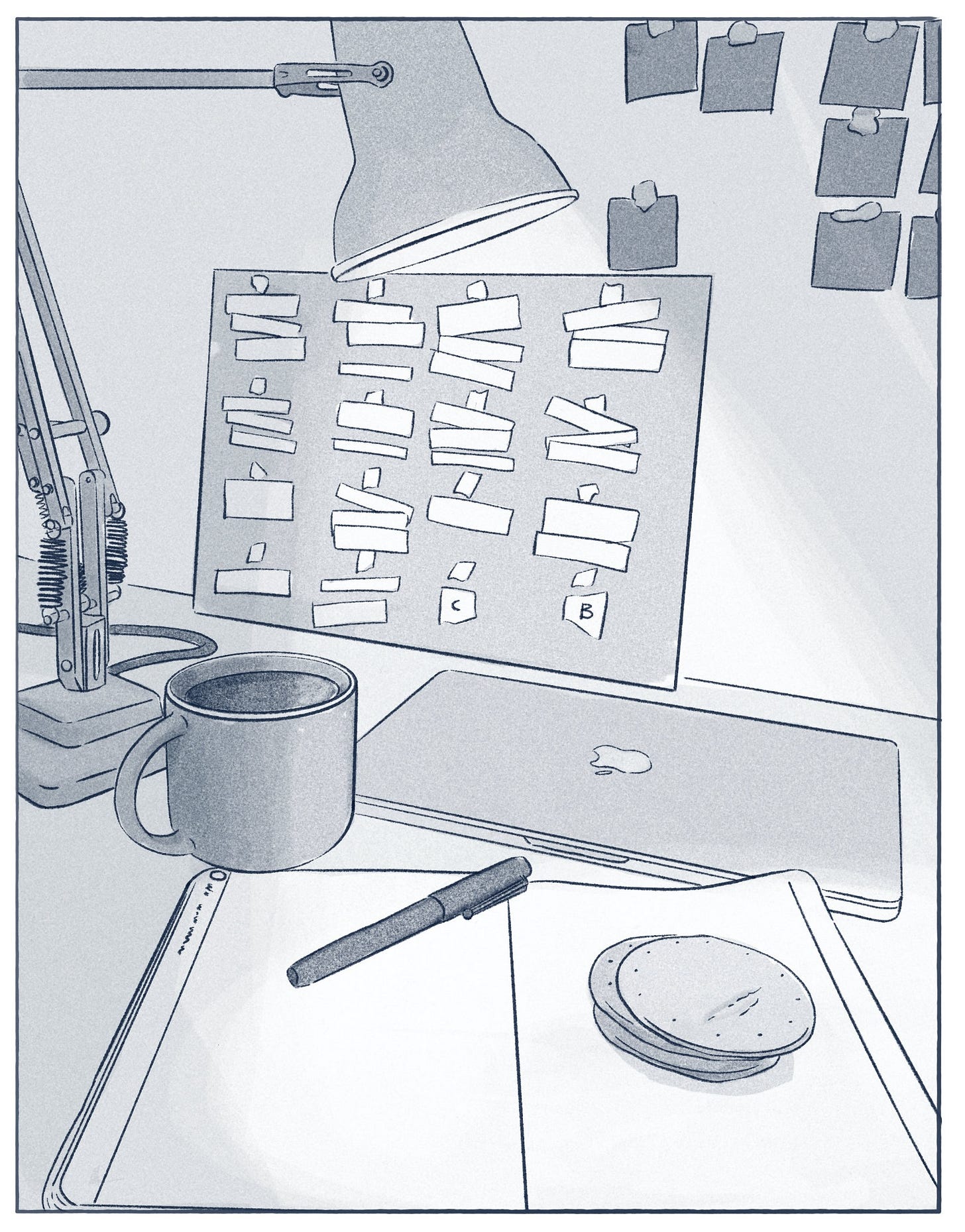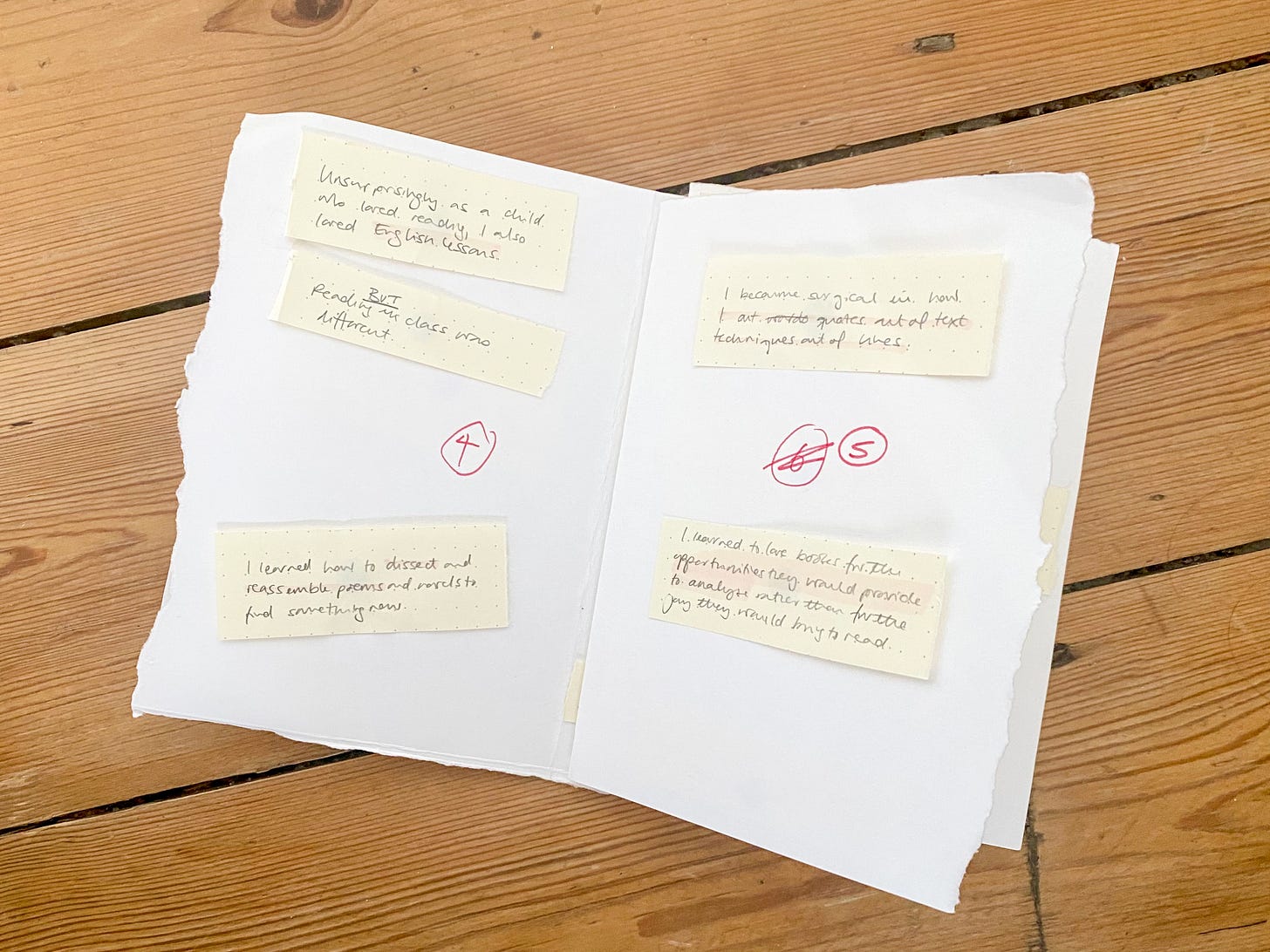This time last year I was starting the Royal Drawing School’s Drawing the Graphic Novel course, with the brilliant Emily Haworth-Booth.
That course really shifted how I plan my work.
Before, a lot of my planning happened in my head; after a period of mulling an idea over passively at the back of my mind, something close to fully formed would spring forth. I used to wish I could print straight from my brain. But that method relied on me being in the right mood and often led to quite fragile ideas because the only place they existed was in my head, an often messy and changeable place.
When I started to work on longer narrative pieces, I knew that method wouldn’t work anymore. I couldn’t just hold a whole story in my mind. I needed something more robust to allow me to work on it over weeks.
Using what we learned in the course and my own trial and error, this is the best method I’ve found for planning narrative newsletters.
Coming up with overarching themes and ideas is still very much led by what’s on my mind, as you can tell from the fact I’ve written and drawn about everything from fig rolls to rivers and Barbara Hepworth. I try to keep a note of these in the moment because there’s no substitute for wanting to make something.
When I have an idea I want to work on, I’ll set aside time to physically free write everything related down. I work on scrap pulled out of the back of old notebooks, so I don’t feel precious about writing down terrible ideas. Sometimes those ideas come out in sequence, sometimes they don’t.
That doesn’t matter because the next step is to cut them all up. I write each line separately and work in little columns to make this easier. Eventually I’m left with a tiny pile of strips of paper.
Then I play with how those little strips might jigsaw puzzle together. I try out different orders and arcs. If I’m struggling, I go through the pile and highlight different kinds of images or themes in each little strip to identify different patterns or sequences. This was what we did in class and I loved it.
Usually, after a little while, something presents itself. When I’m roughly happy with the order, I’ll blu-tac each of the strips to my storyboard AKA a repurposed piece of packaging card. It’s at this point I’ll make sure everything is divided into the right number of pages for a zine as well. I use blu-tac so that I can go back and change or add in new strips as the work develops. The big C and B are there to remind me to make a cover (C) and back (B) for the zine version of the story within my page allowance.
Once I have the shape of a story occasionally, I’ll draw some very loose and very tiny thumbnails that probably just look like scribbles to me. Or I might stick my little bits of paper into the paper prototype of the zine I’m creating if it’s got a more complex layout where I need to see how the story will fold/unfold.
This method has stuck for me for two reasons. First, it really challenges you to think about the shape of a piece from the start, and not be precious about the way something comes together. You can organise, reorder and emphasise anything you want. Second, it’s fun. I no longer feel like I want to just print from my brain because I love playing with my little bits of paper. Loving the process has been huge for me in coming back into making personal work, and these physical parts of the process that are equal parts silly and satisfying are a big part of that.
So that’s how I’m planning on paper. Let me know if you’ve found any great planning methods, I’m still trying to find something that bridges me between my tiny unintelligible thumbnail sketches and final images.
Write/draw again soon,
Natalie










Thanks heaps for sharing your process! It's always fascinating to see what goes into making something. And I love the post-it note style workflow!
This is cool! It reminds me of the way filmmakers use post-it notes of different colors to organize a storyline / edit. UX designers use a similar method to map out the user’s journey. It makes a lot of sense especially, tho, for planning a work on paper, which is not only finite, but of a specific number of pages, including B and C, as you note. And yeah— totally looks like it adds a lot of fun to the process! ✨